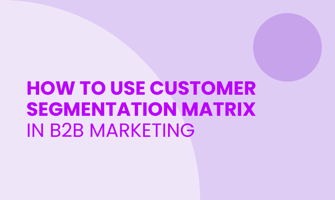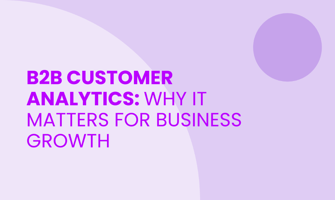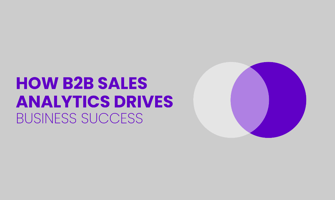In B2B marketing, finding and connecting with the right business clients can be tough. Many...
What Is Customer Service Analytics? Key Benefits for Business
Your B2B business cannot afford to overlook service issues that damage client relationships. Missed support requests, slow response times, and unresolved problems can lead to lost contracts, reduced trust, and unexpected churn. When each client represents long-term value, small mistakes turn into big risks.
Customer service analytics helps your business avoid these problems by turning service data into clear insights. It shows where support is falling short and where you can improve client satisfaction and retention. This article explains what customer service analytics is, the key benefits for B2B businesses, and how you can use it to drive better results.
Read "How Customer Data Analytics Improves ROI" for a simple take on the topic.
What Is Customer Service Analytics?
Customer service analytics is the process of collecting and analyzing data from customer support interactions to understand how well your business is serving its clients. It looks at information like response times, resolution rates, customer feedback, and service trends to measure performance and find areas for improvement.
In a B2B business, customer service analytics helps you track how your support impacts long-term client relationships, contract renewals, and overall customer satisfaction. It turns service data into clear insights that guide your teams in delivering better support and maintaining strong client partnerships.
Key Benefits of Customer Service Analytics for B2B Businesses
1. Improve Customer Satisfaction
Customer service analytics helps your B2B business understand how well you are meeting client expectations at every stage of support. It tracks service quality across accounts, showing where response times, issue resolution, or communication may be falling short. In B2B, where relationships are long-term and contracts are often large, even small service failures can damage trust and lead to dissatisfaction.
By using analytics, your business can monitor client interactions in detail and identify patterns that impact satisfaction. This allows you to proactively address recurring issues, customize support for key accounts, and ensure that service levels match client expectations outlined in service level agreements (SLAs).
2. Enhance Agent Performance
Customer service analytics gives your business clear data on how support teams handle client requests. It tracks metrics like case resolution time, first contact resolution, and workload distribution. In B2B environments, where agents often manage complex issues for high-value clients, performance gaps can lead to delays and unhappy customers.
With detailed analytics, your business can identify which agents or AI marketing agents need additional training, where processes slow down, and how to allocate resources more effectively. This leads to better handling of priority accounts, improved adherence to SLAs, and stronger client relationships through consistent and professional service delivery.
3. Reduce Customer Churn
B2B customer churn often happens when service issues build up without being addressed. Customer service analytics helps your business detect early warning signs, such as repeated complaints, long resolution times, or declining engagement from clients. Since losing a single B2B client can mean losing significant recurring revenue, reducing churn is critical.
By analyzing service data, your business can flag at-risk accounts before they decide to leave. This allows account managers and support teams to step in with corrective actions, offer tailored solutions, and strengthen client retention strategies. Preventing churn protects your revenue streams and maintains long-term contract value.
4. Increase Operational Efficiency
Customer service analytics shows where your support processes are wasting time or resources. It highlights bottlenecks, unnecessary escalations, and repetitive tasks that slow down case handling. In B2B businesses, where service teams deal with complex client needs, inefficiencies can lead to higher operational costs and missed deadlines.
By using analytics to streamline workflows, your business can reduce average handling times, improve resource allocation, and ensure faster resolution for client issues. This not only lowers service delivery costs but also helps meet contractual obligations more effectively, supporting profitability and client satisfaction at the same time.
5. Drive Data-Informed Decisions
Customer service analytics provides your business with detailed insights that link service performance to client outcomes and revenue impact. Instead of relying on assumptions, your leadership team can use real data to adjust support strategies, prioritize key accounts, and align resources with business goals.
For B2B businesses, this means being able to forecast client needs, plan for capacity based on service trends, and ensure that service quality supports customer lifetime value (CLV). Data-informed decisions help your business improve account management, strengthen upsell opportunities, and maintain high standards across all client interactions.
Key Customer Service Analytics Metrics to Track for B2B Business
1. Monitor First Response Time
First response time measures how long your business takes to reply to a customer after they ask for help. It tracks the time from when a customer sends a request to when they get the first answer. In B2B, fast responses show clients that their issues are being handled, which helps build trust and keeps the relationship strong.
When response times are too slow, customers may feel ignored and lose confidence in your service. Tracking this metric helps your business stay alert and improve how quickly your team reacts to client needs.
2. Measure Customer Satisfaction Score (CSAT)
Customer Satisfaction Score, or CSAT, is a metric that tells you how happy customers are with a specific service or support interaction. After a case is resolved, customers are asked to rate their experience, usually on a simple scale like 1 to 5. In B2B, this feedback shows how well your team is meeting client expectations during each interaction.
Measuring CSAT helps your business find out if customers are satisfied or if there are problems in your service process. Regular tracking allows you to fix issues early and keep customers more engaged and loyal.
3. Track Net Promoter Score (NPS)
Net Promoter Score, or NPS, measures how likely customers are to recommend your business to others. It asks one question: "How likely are you to recommend us on a scale of 0 to 10?" In B2B, a high NPS means your clients trust your service enough to suggest it to partners or peers.
Tracking NPS helps your business understand overall customer loyalty, not just satisfaction after one interaction. It shows if your service is creating long-term positive relationships or if there are risks of losing important clients.
4. Analyze Customer Churn Rate
Customer churn rate measures how many customers stop doing business with you over a period of time. It shows the percentage of clients that leave. For B2B businesses, losing a single client can have a big impact because each account often represents significant revenue.
By analyzing churn rate, your business can spot patterns and reasons why customers leave. This allows you to take action to keep clients before they decide to end the relationship.
5. Evaluate Customer Lifetime Value (CLV)
Customer Lifetime Value, or CLV, is the total revenue a customer is expected to bring to your business during the entire relationship. In B2B, knowing CLV helps you understand which clients are the most valuable over time, not just in a single sale.
Evaluating CLV helps your business focus resources on keeping high-value customers and finding ways to grow those accounts. It also supports better planning by showing how much long-term income you can expect from your client base.
How 180ops Turns Customer Service Analytics into Business Growth for B2B
1. Integrate Customer Service Data with Sales and Account Insights
180ops connects your customer service data with sales, marketing, financial, and external data sources. For B2B businesses, this means you get a full view of each client by combining service interactions with account performance and pipeline activity. Instead of looking at customer service in isolation, 180ops helps you understand how support quality impacts sales opportunities and client relationships.
By integrating these data points, your business can see how service delays, frequent support issues, or positive interactions influence buying readiness and account growth potential. This connection helps your teams work together using the same account-based insights to improve both service and revenue outcomes.
2. Identify Churn Risks Through Predictive Analytics
180ops uses predictive analytics to detect early signs that a client may leave. For B2B businesses, this includes analyzing patterns across customer service interactions, sales performance, and market behavior. The platform highlights accounts showing reduced engagement, repeated issues, or negative trends linked to churn.
With these insights, your business can act before a client decides to end the relationship. Account managers and service teams can focus on solving problems, improving communication, and offering solutions that keep valuable clients onboard. This proactive approach protects long-term revenue and supports customer retention strategies.
3. Highlight Opportunities for Account Expansion
180ops analyzes your customer data to uncover accounts with growth potential. By reviewing customer service trends alongside sales and account data, the platform shows where satisfied clients may be ready for upselling or cross-selling. In B2B, this helps your business focus on clients who are more likely to increase their use of your services or products.
With clear insights, your teams can identify when positive service experiences and strong engagement signal the right time to offer additional solutions. This targeted approach supports account expansion without guessing, helping your business grow revenue from existing clients.
4. Provide Real-Time Visibility into Customer Health
180ops gives your B2B business real-time dashboards that display customer health across all accounts. This includes combining service quality, sales activity, and external market data to give a full picture of each client’s status. Instead of waiting for monthly reports, your teams can monitor changes as they happen.
This visibility helps you quickly spot accounts that need attention or those that are showing strong growth signals. Real-time insights ensure that your service, sales, and management teams can respond to client needs immediately, keeping relationships strong and avoiding missed opportunities.
5. Support Data-Driven Decisions Across Teams
180ops ensures that all departments in your B2B business work with the same reliable data. By connecting customer service analytics with sales, marketing, and financial insights, the platform helps teams make informed decisions based on complete account information.
This shared data environment allows your business to coordinate strategies, prioritize high-value clients, and address service issues that could impact revenue. It removes silos between teams, making sure that every decision supports overall business goals and client satisfaction.
6. Align Customer Service Performance with Revenue Goals
180ops helps your B2B business link customer service performance directly to revenue outcomes. The platform shows how service interactions affect client retention, upsell opportunities, and long-term account value. This alignment helps leadership teams focus on improving service areas that have the biggest impact on growth and profitability.
By understanding this connection, your business can set clear targets for service teams that support financial goals. This ensures that customer service is not just seen as a support function but as a key driver in achieving revenue and client success objectives.
Conclusion
Customer service analytics helps your B2B business understand and improve every part of client support. By using data from customer interactions, you can spot problems early, enhance service performance, reduce churn, and strengthen long-term client relationships. It turns everyday support activities into opportunities to protect revenue and drive business growth.
180ops is a revenue intelligence platform that helps your B2B business turn customer service analytics into clear, actionable strategies. It connects service data with sales and account insights, so you can improve client retention, identify risks, and ensure your service performance supports business growth.
Contact us to take control of your customer service analytics and achieve better outcomes for your B2B business.
FAQ
What is customer service analytics?
Customer service analytics is the process of using data from customer interactions to measure and improve support performance.
How does customer service analytics improve customer satisfaction?
It identifies service issues and helps your business respond faster, solve problems better, and meet client expectations.
What are the key metrics in customer service analytics?
Key metrics include first response time, customer satisfaction score (CSAT), net promoter score (NPS), churn rate, and customer lifetime value (CLV).
How can businesses implement customer service analytics effectively?
Collect service data, track important metrics, and use tools like 180ops to turn insights into actions that improve client retention and performance.
What tools are best for customer service analytics?
Businesses use platforms that integrate data, provide real-time insights, and support decision making. 180ops helps connect service data with business growth strategies.




